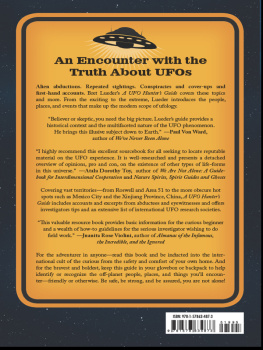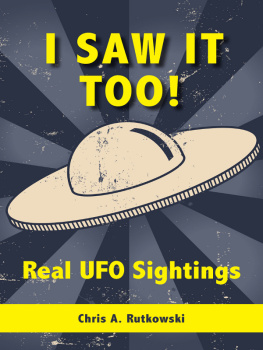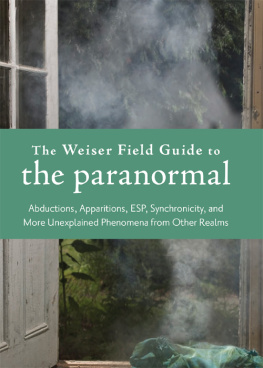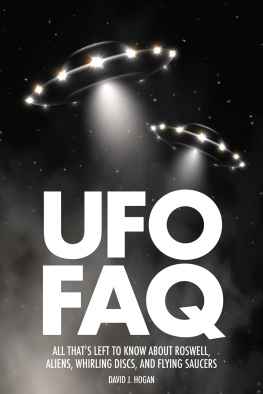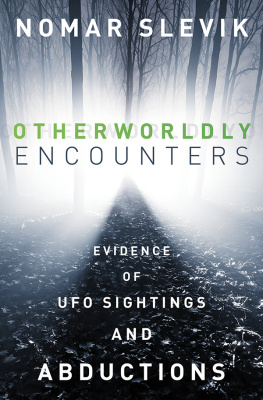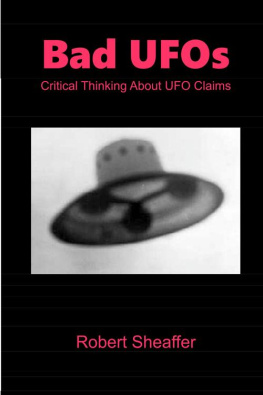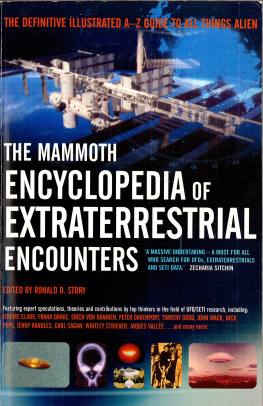ASIDE FROM THE MANY EFFORTS of the world-renowned researchers who have graciously contributed to this book, it could not have been done in the way it has been if it were not for the kind assistance of several key individuals: Ruben Uriarte, Marcia Schafer, Suzy Stevens, Kim Freeman, and especially Victoria Jack.
Introduction
M any of us have been born into a society where unidentified flying objects, or UFOs, are already part of popular culture. From the friendly, multicolored lights of the craft in Steven Spielberg's classic movie E.T. to the ominous and city-sized disks in the movie Independence Day, Hollywood has firmly implanted images of UFOs in the minds of people worldwide.
Energized by the influence of Hollywood, UFOs have been seen and heard across a wide spectrum of media, including musical genres, children's television cartoons, and poster art. The stereotypical image of a space alien, popularized on the cover of the famous Whitley Strieber book Communion (1987), can be seen on coffee cups, baseball hats, and bumper stickersthe image of an alleged UFO occupant known as a Gray. Not coincidentally, Strieber's book was later made into a movie (1989) starring Christopher Walken as Strieber (see www.ufopop.org).
It wasn't until the first publicly reported sighting on June 24, 1947, in Washington State, however, that the term flying saucer was born. Hollywood now had a new and rich source of material to fuel its moneyand some say mind controlmachine. In his now famous book Report on Unidentified Flying Objects (1956), Captain Edward J. Ruppelt coined the term unidentified flying object, or UFOs, to better describe these various phenomena, and henceforth that has been the preferred term used to identify what appearat least for the time beingto be indefinable. Hollywood has adopted the term as well.
For researchers, however, many questions have arisen since that fateful day: Where do UFOs originate? What do the world's governments and military establishments know about the phenomena? How long before 1947 did they know about them? Is there really a cover-up of information? Are these objects really spaceships from other planets? And the biggie: What is a UFO? These and other questions have all, so far, remained unanswered. Well, at least in publicsay some.
Among the few brave researchers who offer explanations, many heated arguments arise. One claims that UFOs are from outer space, while another says that anyone who believes in UFOs is a wacko. Some more grounded researchers admit the UFOs could be from outer space or other planets, but some continue to insist that they are nothing more than misidentified planets, stars, meteor fireballs, comets, and other aerial and weather phenomena covering a wide range of situations. The arguing goes back and forth, each side claiming to have expert analysis and opinion. The result is mental fatigue of the highest order.
Many ufologists, or people who research UFO sightings and cases, have suffered from burnout, nervous breakdown, and other types of psychosis. Often, the information available conflicts, making the mental strain on investigations more difficult. Worse still, many have died in their pursuit of the truth. The television series The X-Files (19932002) is a good example of the portrayal of situations that arise from seemingly harmless UFO investigations. The movies Hangar 181980) and The Arrival (1996) and the television series Stargate SG-1 (19972007) are good examples of the kinds of situations an individual may encounter when in pursuit of UFO and/or UFO-related information.
It is true that Hollywood hypes this kind of intrigue, because it does help to sell movie tickets and advertising. But these dangers are real, with numerous accounts of life-threatening situations concerning UFOs reported by both military/government and civilian research efforts. As will become clear in the pages that follow, the study of UFOs can go from fun to deadly serious in a short time.
You only have to witness for yourself the signs posted outside of Area 51 in the Nevada desert, which state that trespassers could be shot. A common Area 51 sign reads:
WARNING: U.S. Air Force Installation. It is unlawful to enter this area without permission of the Installation Commander Sec. 21, Internal Security Act of 1950; 50 U.S.C 797. While on this Installation, all personnel and the property under their control are subject to search. USE OF DEADLY FORCE AUTHORIZED.
Perhaps most shocking, however, are the reports of the mysterious men in black (MiB) and the many techniques they use to harass UFO researchers, witnesses, and their familiesdisinformation; physical, economic, and/or psychological threat; and the forcible acquisition and intentional destruction of evidence. These MiBs have allegedly blocked or destroyed many investigations and reports and have kept competent researchers from pursuing evidence and information. All these things have been reported.
So how are we supposed to make sense of this miasma of facts, conflicting information, incomprehensible details, and potential life-threatening danger? Many will remain in a state of denial and go about their daily lives. More power to them. Others will go running away screaming in fear that any of it could be true. They will find their way.
In the end, a brave few will handle the emotional strain this knowledge can bring; they will venture forth and seek answers to phenomena that could potentially affect every person on Earthphenomena that have been taking place since long before 1947. Reports in California alone go back to 1896. And it has been alleged that both Nazi Germany and U.S. President Franklin Delano Roosevelt had meetings with alien races as early as 1933 (see BRANTON, aka Bruce Alan Walton, The Omega Files: Secret Nazi UFO Bases Revealed [2000]).
Nor is the idea that UFOs are from worlds other than Earth new. It has been with humanity since the dawn of recorded time. Cave paintings of what appear to be classic saucer-shaped disks can be found in modern-day Lascaux, France, that are thought to be 17,000 years old. Other rock art in Mali, West Africa (the Dogon tribe), Australia (the Aborigines), North America (several Native American tribes), and many spots in Europe (Celtic, Etruscan, and other early peoples) all show indications that they were visited by, learned from, and were guided by beings from other worlds, some of which are described as traveling in what today are perceived as UFOs.

